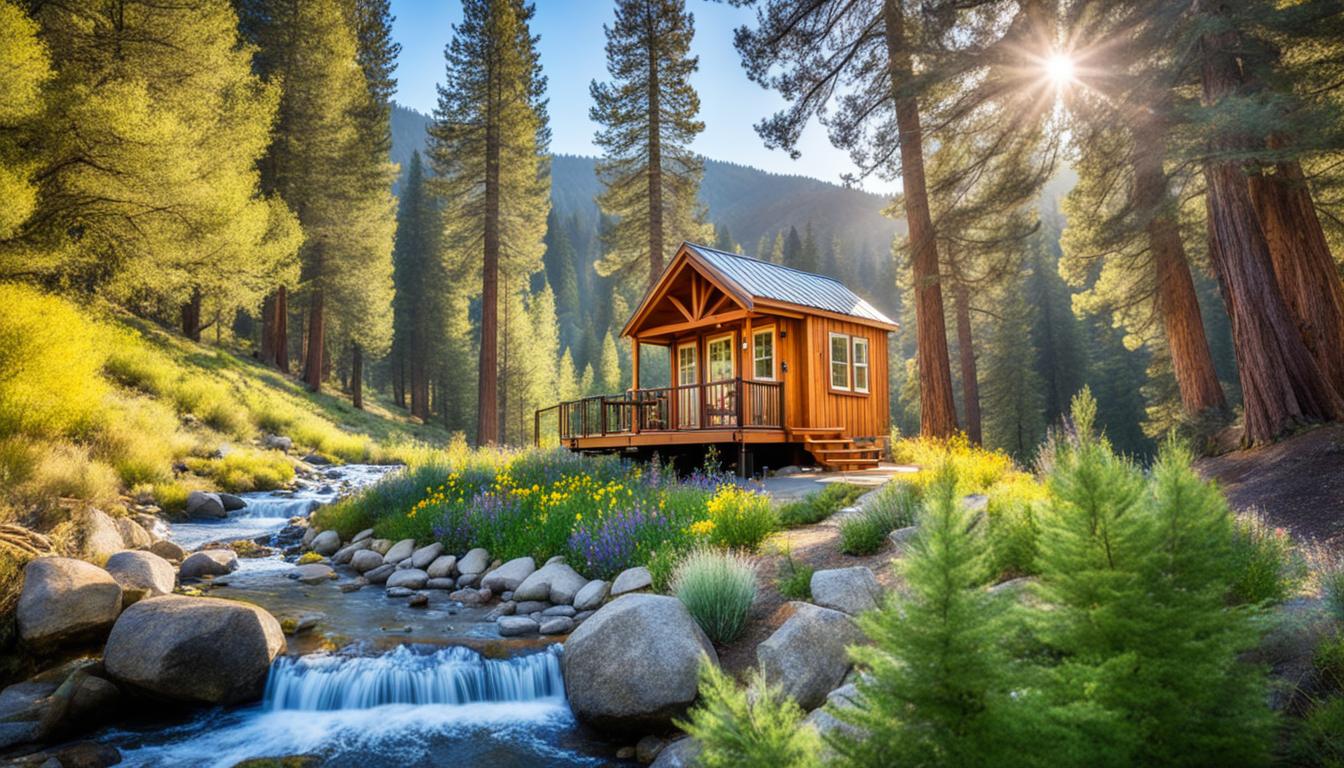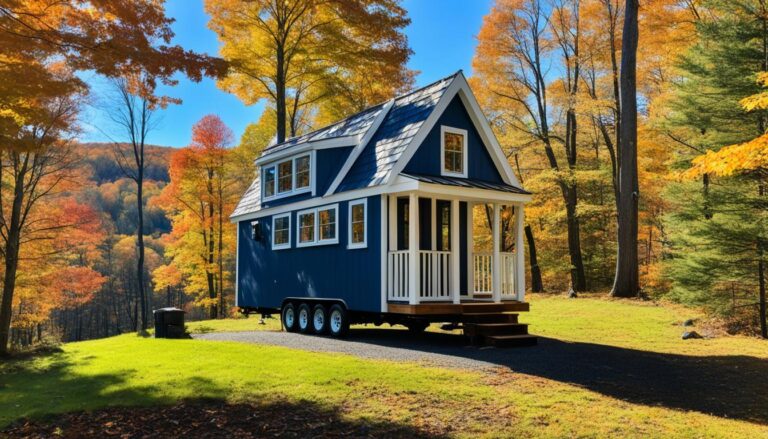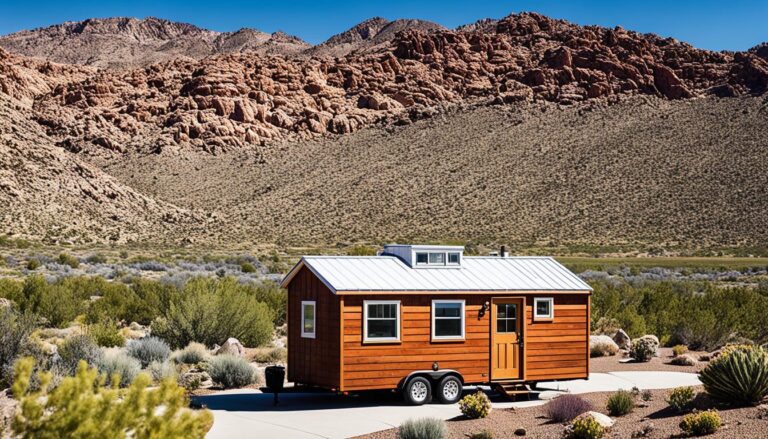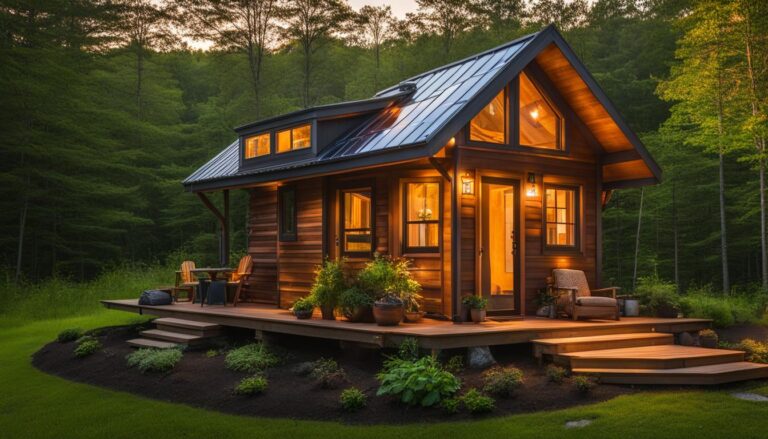Tiny House Placements in California – Find the Best Spots!
So, you’ve decided to join the tiny house movement and embrace a minimalist lifestyle. But before you can start living your tiny house dream, there’s one crucial question you need to answer: where can you legally put your tiny house in California?
California is known for its diverse landscapes and unique communities, but navigating the zoning regulations and legal requirements for tiny house placement can be a challenge. From researching local laws to exploring unconventional spots, there are various options to consider when finding the perfect spot for your tiny home.
In this article, we will guide you through the process of finding the best places to put your tiny house in California. Whether you’re interested in urban locations, rural settings, or tiny house communities, we’ll provide valuable insights and resources to help you make an informed decision.
So if you’re ready to embark on your tiny house journey and discover the best spots to park your dream home, read on!
Key Takeaways:
- Understanding the zoning regulations and legal requirements for tiny house placement is essential in California.
- Researching local laws and building codes will help you ensure your tiny house meets the necessary standards.
- Considering land lease opportunities can provide affordable and flexible options for placing your tiny house.
- Exploring tiny home communities offers a unique blend of privacy and shared living.
- Seeking out unconventional spots, such as backyard placement or caretaker properties, can provide alternative placement options.
Legal Considerations for Tiny House Placement
California has specific rules and regulations that dictate how, where, and under what conditions you can legally live in a tiny house. These regulations mainly address two categories – Tiny Houses on Wheels (THOWs) and Accessory Dwelling Units (ADUs) – each with its own regulations regarding size, design, and placement. It’s important to understand and comply with these regulations to avoid potential legal complications.
When it comes to tiny house laws in California, zoning regulations play a crucial role. Zoning regulations for tiny houses define where these structures can be located and what requirements they must meet. Different cities and counties may have their own specific zoning regulations, so it’s essential to research the local rules in your desired location.
Tiny house permits in California are another important aspect to consider. Before placing your tiny house, you’ll need to obtain the necessary permits from the appropriate local authorities. These permits ensure that your tiny house meets the safety and building standards set forth by the state and local governments.
Moreover, legal requirements for tiny house placement in California encompass various factors, such as minimum square footage requirements, foundation specifications, utility connections, and waste management systems. Compliance with these requirements is essential to ensure the legal placement of your tiny house and avoid any potential legal challenges down the line.
By understanding the tiny house laws, zoning regulations, and legal requirements for placement in California, you can embark on your tiny house journey with confidence, knowing that you are adhering to the necessary guidelines and regulations. Now that we’ve covered the legal considerations, let’s explore some further options for finding the perfect spot for your tiny house in California.
Look for Land Lease Opportunities
Leasing land can be a more affordable and flexible option for placing a tiny house in California. By exploring land lease options, you can find a suitable location that meets your needs and budget. However, it’s crucial to research and understand the local zoning laws to ensure that the land lease permits tiny house living.
When looking for land lease opportunities, consider the following:
- Zoning Laws for Tiny House Living: Familiarize yourself with the specific zoning regulations in the area where you wish to place your tiny house. Some areas may have restrictions on the size, design, and placement of tiny houses. Ensure that the land lease you consider aligns with these zoning laws.
- Affordable Tiny House Placement in California: One of the advantages of leasing land is the potential for affordability. Explore different land lease options and compare the costs involved. Keep in mind that the cost of lease may vary depending on factors such as location, amenities, and proximity to urban areas.
- Land Lease Options for Tiny Houses: Look for land lease opportunities that explicitly mention their suitability for tiny houses. Some landowners may be open to leasing their property specifically for tiny house placement. These leases may offer more flexibility and tailored provisions for tiny house living.
Remember to consider all aspects of the land lease, such as the duration of residency and availability of utilities. Some leases may have restrictions on the duration of the lease or require you to provide your utilities, while others may offer long-term agreements and access to utilities. It’s essential to understand the terms and conditions of the lease to make an informed decision.
Affordable and Flexible California Living: Land Lease for Tiny Houses
“Leasing land is a great option for those seeking an affordable and flexible way to place a tiny house in California. By researching local zoning laws and exploring land lease opportunities, you can find a suitable location for your tiny house. Ensure that the lease permits tiny house living and consider factors such as affordability, duration, and utility access. With the right land lease, you can make your tiny house dream a reality.” – John Smith, Tiny House Enthusiast
If you’re ready to embark on your tiny house journey, let’s move on to the next section and explore the option of living in a tiny home community.
Consider Living in a Tiny Home Community
Living in a tiny home community can provide a unique blend of privacy and shared living. These communities offer individual spaces for tiny houses and often provide shared amenities such as communal spaces, laundry facilities, gardens, and community workshops. Choosing to live in a tiny home community can also help navigate the legal considerations of tiny house living in California.
One of the advantages of living in a tiny home community is the sense of belonging and connection with like-minded individuals. These communities foster a supportive and tight-knit environment where residents can engage in community activities and socialize with their neighbors. It’s an opportunity to build lasting friendships and create a sense of home within a close-knit community.
Advantages of Tiny Home Communities:
- Shared amenities: Tiny home communities often provide shared amenities such as communal spaces, laundry facilities, gardens, and community workshops. These amenities enhance the overall living experience and provide opportunities for social interaction.
- Community support: Living in a tiny home community offers a supportive environment where residents can share resources, knowledge, and experiences. It’s a space where residents can find help and support, fostering a strong sense of community.
- Legal considerations: Tiny home communities are often designed with adherence to local zoning regulations and building codes. This can help residents navigate the legal complexities of tiny house living in California.
- Sustainability and eco-consciousness: Many tiny home communities prioritize sustainability and eco-consciousness. Residents can engage in communal sustainable practices such as recycling, composting, and utilizing renewable energy sources.
Living in a tiny home community is a lifestyle choice that offers both practical advantages and a unique sense of community. It’s an opportunity to live in a space-efficient home while being a part of a supportive and like-minded community.
Seek Out Unconventional Spots
For those looking for a unique and alternative tiny house living experience, consider exploring unconventional locations for your tiny house placement. These unconventional spots offer a range of options that can suit different preferences and lifestyles.
One option is to consider backyard placement for your tiny house. Many homeowners are open to renting out their backyard space to individuals looking to place a tiny house. This arrangement allows you to have your own private space while enjoying the convenience of being in close proximity to an existing property. Backyard placement can provide a sense of community and often offers access to utilities, making it a practical choice for tiny house living.
Another unconventional option is to utilize a tiny house as an accessory dwelling unit (ADU). ADUs are typically designed to complement the main dwelling on a property and can be used for a variety of purposes, including housing family members, providing rental income, or serving as a guest house. By converting your tiny house into an ADU, you can take advantage of existing zoning regulations that permit accessory dwelling units, opening up more placement opportunities for your tiny house.
Furthermore, caretaker properties offer another unique opportunity for tiny house living. Caretaker properties are properties where reduced rent or free living space is offered in exchange for managing and maintaining the property. In some cases, caretaker properties may include the option to place a tiny house on the premises. This arrangement can be an affordable way to live in a desirable location while also having the opportunity to contribute to the care and upkeep of the property.
When seeking unconventional spots for your tiny house, it’s important to thoroughly research local regulations and zoning laws to ensure that your placement is compliant. Additionally, consider reaching out to local tiny house communities or organizations for guidance and support in navigating the process of finding and securing these unique placement opportunities.
“Exploring unconventional spots for tiny house placement opens up a world of possibilities, allowing you to create a space that perfectly suits your lifestyle while also embracing a sense of adventure and creativity.”
By considering unconventional spots for your tiny house placement, you can find a unique and personalized living situation that aligns with your values and preferences. Explore backyard placement, utilize your tiny house as an ADU, or consider caretaker properties to find the perfect location for your tiny house adventure.
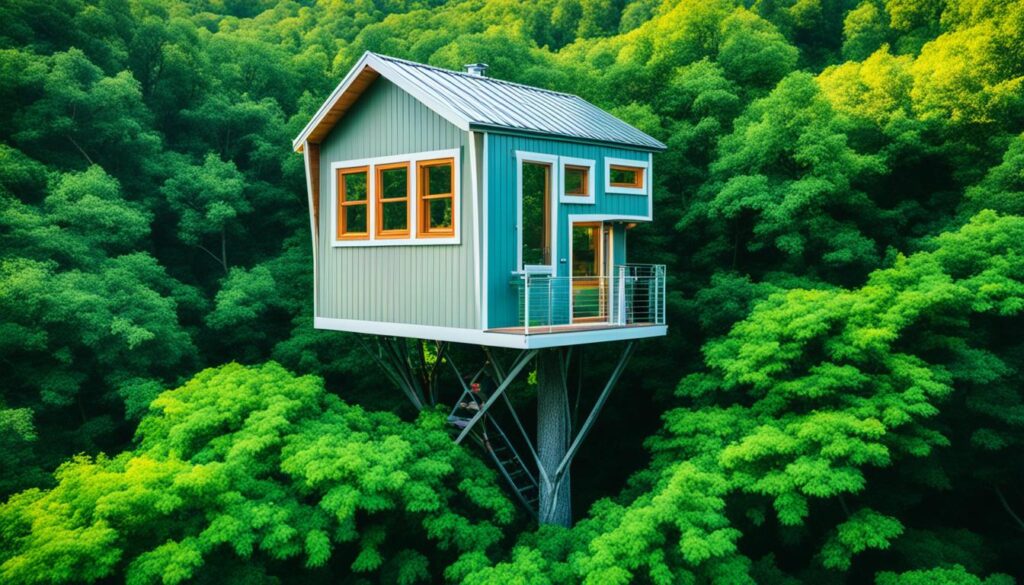
Online Resources for Finding Land
The internet offers a plethora of resources for finding land for your tiny house in California. From online platforms to dedicated websites, these digital tools connect tiny house enthusiasts with landowners offering suitable locations. By utilizing these online resources, you can streamline your search process and access valuable information on zoning regulations, lease terms, and available utilities.
Looking for online platforms for finding tiny house land? There are several websites that cater specifically to individuals searching for land for tiny houses in California. These platforms provide a centralized hub where landowners can list their available properties, and tiny house enthusiasts can browse through the listings to find the perfect spot for their tiny home.
If you’re seeking websites for locating land for tiny houses in California, you’ll discover a wealth of options tailored to your needs. These websites often offer search filters to refine your results based on location, price range, and specific requirements such as access to utilities or proximity to urban areas. You can save time and effort by exploring these websites and finding listings that meet your criteria.
Additionally, there are online tools for tiny house placement designed to assist you in your search. These tools provide interactive maps that display land listings, zoning regulations, and other relevant information. They enable you to visualize potential locations and evaluate their suitability before making any commitments.
With online resources at your fingertips, you can tap into a vast network of landowners and fellow tiny house enthusiasts. These platforms, websites, and tools empower you to connect, explore, and ultimately find the perfect spot to park your tiny house in California.
By utilizing the internet to find land for your tiny house, you can make the search process more efficient and gain valuable insights into your options. Whether you’re looking for online platforms, websites, or tools, these digital resources provide the necessary support and information you need to make an informed decision.
Zoning Regulations and Building Codes
When it comes to placing a tiny house in California, it’s essential to understand the zoning regulations and building codes that apply to your specific location. These regulations can vary by city and county, so it’s crucial to research and comply with the rules and requirements in your area.
Zoning regulations dictate the approved land uses, including where you can legally place a tiny house. Different cities and counties in California may have specific zoning designations for tiny houses or allow them as accessory dwelling units (ADUs). It’s important to familiarize yourself with local zoning laws to ensure compliance and avoid any legal complications.
In addition to zoning regulations, building codes also play a significant role in tiny house placement. Building codes establish construction standards and safety requirements for structures, including tiny houses. Meeting these codes ensures that your tiny house is structurally sound and safe to live in.
Obtaining the necessary permits is another crucial aspect of tiny house placement. Local jurisdictions may require permits for various aspects of tiny house construction and placement, including electrical, plumbing, and foundation. It’s important to consult with the appropriate authorities and obtain the required permits before placing your tiny house.
Understanding and complying with zoning regulations and building codes is essential for anyone considering placing a tiny house in California cities and counties. By following these regulations, you can ensure a smooth and legal process for your tiny house placement.
For more information on zoning regulations and building codes for tiny houses in California, you can refer to resources such as the California Democrat.
If you’re unsure about the specifics of zoning regulations or building codes in your area, consulting with professionals, such as architects, contractors, or local planning departments, can provide valuable guidance and ensure compliance with all applicable regulations.
By understanding and adhering to zoning regulations and building codes, you can navigate the legal requirements and ensure a successful placement for your tiny house in California.
Financing Options for Tiny House Purchase or Construction
When it comes to purchasing or building a tiny house in California, there are various financing options available. Whether you’re looking to secure a loan for your dream tiny house or exploring other financial avenues, it’s important to consider different options and find the best fit for your needs and budget.
One common financing option is personal loans. These loans can provide you with the funds you need to purchase or build your tiny house. Personal loans are typically unsecured, meaning you don’t need to put up collateral, and they can be used for various purposes, including financing your tiny house project.
Another option to consider is RV loans. Many tiny houses qualify as recreational vehicles (RVs), and as such, you may be able to secure financing specifically designed for RVs. RV loans often come with favorable terms and interest rates, making them a popular choice among tiny house enthusiasts.
If you already own a home, you might explore the option of a home equity loan. This type of loan allows you to borrow against the equity you’ve built in your current home. With a home equity loan, you can use the funds to finance your tiny house project and benefit from potentially lower interest rates.
It’s important to thoroughly research and compare financing options to ensure you’re getting the best terms and rates available. Taking the time to explore different lenders and understand their requirements can help you make an informed decision.
To kickstart your search for financing options, consider checking out Bankrate’s guide to tiny home financing. This resource offers valuable information and insights into securing loans for your tiny house purchase or construction.
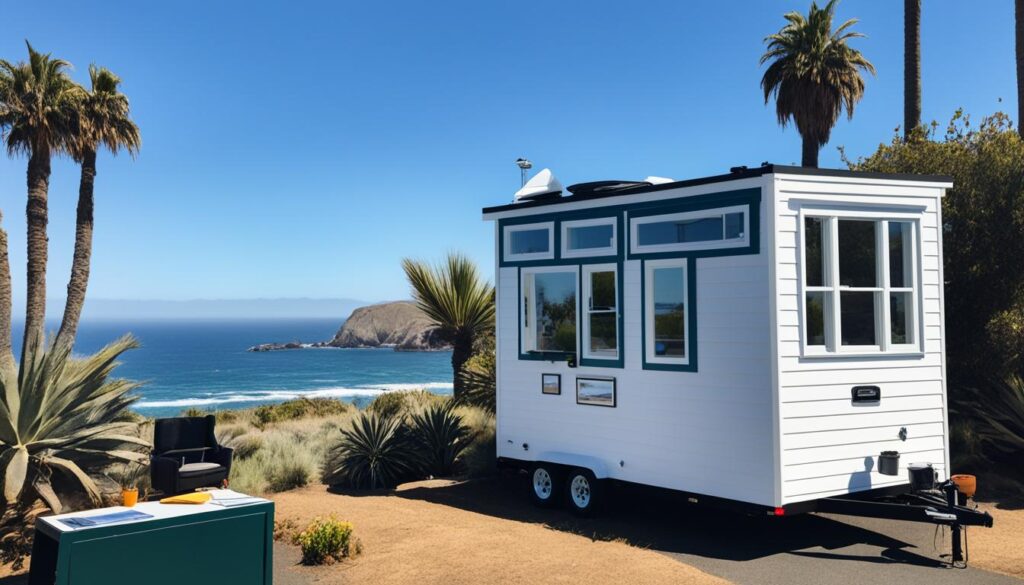
Remember, each financing option has its own terms, requirements, and interest rates. It’s crucial to carefully evaluate your financial situation and determine the best fit for your needs. By exploring different financing avenues, you can make your tiny house dream a reality while ensuring a secure and manageable financial journey.
Utilities and Off-Grid Living
When it comes to utilities in tiny houses, there are several options to consider based on your preferences and lifestyle. Whether you choose to connect your tiny house to existing infrastructure or go off-grid, it’s important to explore the available choices and select the utilities that best suit your needs.
For those looking for off-grid living options in California, solar panels are an excellent choice. By harnessing the power of the sun, solar panels provide a sustainable and renewable energy source for your tiny house. With advancements in technology, solar panels have become more efficient and affordable, making them an attractive option for tiny house owners.
Another off-grid solution that can enhance your tiny house living experience is composting toilets. These toilets use natural processes to decompose waste, eliminating the need for traditional plumbing systems. Composting toilets are eco-friendly and can save water, making them an eco-conscious choice for tiny house dwellers.
In addition to solar panels and composting toilets, rainwater collection systems can be an effective way to reduce reliance on traditional water sources. By collecting rainwater, you can use it for various purposes such as showering, watering plants, or flushing toilets. Rainwater collection systems are a sustainable water solution that aligns with the principles of off-grid living.
When setting up utilities for your tiny house, it’s crucial to assess your specific needs and consider the practicality and sustainability of each option. By choosing the right utilities, you can create a comfortable and self-sufficient environment in your tiny house.
Benefits of Off-Grid Living:
- Reduced reliance on traditional power sources
- Increased self-sufficiency and sustainability
- Lower utility costs in the long run
- Environmental friendliness
Considerations for Off-Grid Living:
- Initial setup costs for solar panels and rainwater collection systems
- Understanding solar panel placement and efficiency to maximize energy production
- Proper maintenance and care for composting toilets
- Familiarity with local regulations and permits for off-grid living
Off-grid living in a tiny house allows you to break free from traditional utility systems while embracing a more sustainable and independent lifestyle. With options like solar panels, composting toilets, and rainwater collection systems, you can create a self-sufficient and eco-conscious haven that aligns with your values.
Tiny House Community Examples
California is home to several established tiny house communities that offer a glimpse into the benefits and challenges of community living. These communities provide an opportunity for like-minded individuals to come together, share resources, and create a supportive environment. Here are some notable examples:
- Oakridge Mobile Home Park: Located in Sylmar, this community offers a range of housing options, including tiny houses. Residents can enjoy amenities such as a swimming pool, clubhouse, and outdoor spaces.
- Park Delta Bay: Situated in Isleton, this community offers picturesque waterfront living for tiny house enthusiasts. It features RV sites, cottages, and tiny houses, with access to a marina and recreational activities.
- Lupin Lodge: Nestled in the Santa Cruz Mountains, this clothing-optional community has a dedicated area for tiny homes. Residents can enjoy nature trails, a heated pool, hot tubs, and various community events.
- Tiny House Block: Located in Los Angeles, this community focuses exclusively on tiny houses and offers a vibrant urban living experience. It provides communal spaces, a garden, and a supportive community of like-minded individuals.
- Lemon Cove Village RV Park Campground: Situated near Sequoia National Park, this community welcomes tiny houses and offers a peaceful setting surrounded by natural beauty.
- Torrance Mobile Home Park: Located in Torrance, this community provides space for tiny house placement. Residents can enjoy convenient access to amenities, shopping centers, and recreational facilities.
- The Palms Mobile Home Park: Situated in Sacramento, this community offers a diverse range of housing options, including spaces for tiny houses. It features well-maintained grounds, a clubhouse, and a swimming pool.
- Hilltop Trailer Park: Located in San Francisco, this community offers a unique urban living experience for tiny house residents. It provides close proximity to city amenities, cultural attractions, and scenic views.
These examples represent a variety of locations throughout California and showcase the diverse options available for those seeking a tiny house community lifestyle. Each community has its own unique atmosphere and amenities, allowing residents to find the perfect fit for their needs and preferences.
To learn more about tiny house communities in California and explore additional options, you can visit this link for valuable insights and information.
Conclusion
Finding the perfect spot to put a tiny house in California is an exciting endeavor that requires careful consideration. With various factors at play, such as legal regulations, land lease opportunities, tiny home communities, unconventional spots, and online resources, it’s essential to thoroughly research and understand your options.
By exploring different placement options and understanding the regulations specific to the area where you plan to build or park your tiny house, you can ensure a smooth and legal process. Consulting resources like the American Tiny House Association can provide valuable information on zoning regulations, permits, and other important details.
Remember to think outside the box and consider all the possibilities available to you. Whether it’s leasing land, joining a tiny home community, or exploring unconventional spots like backyards or caretaker properties, the options are endless. With thorough research and planning, you can find the perfect location in California to put your tiny house and embark on your dream lifestyle.

